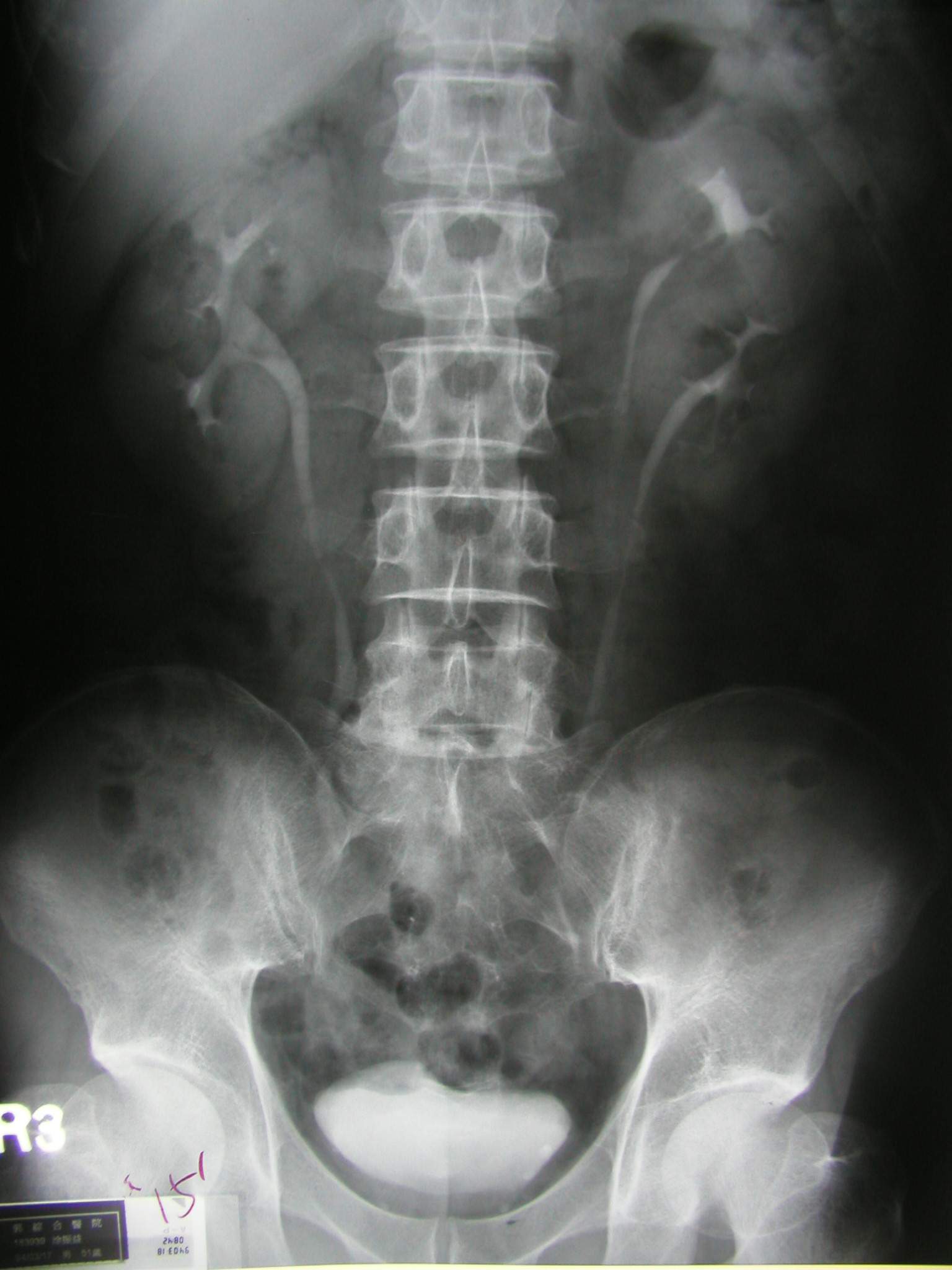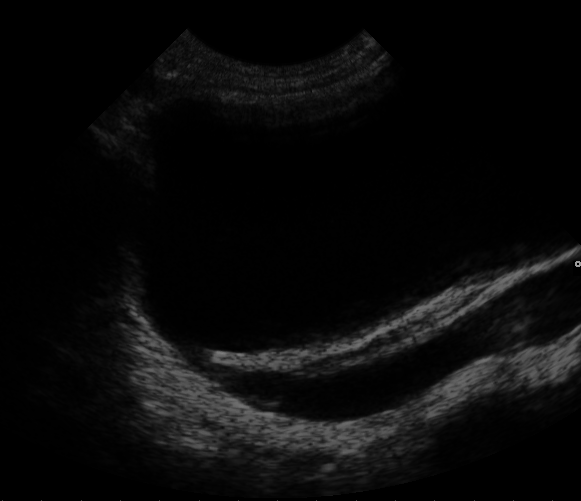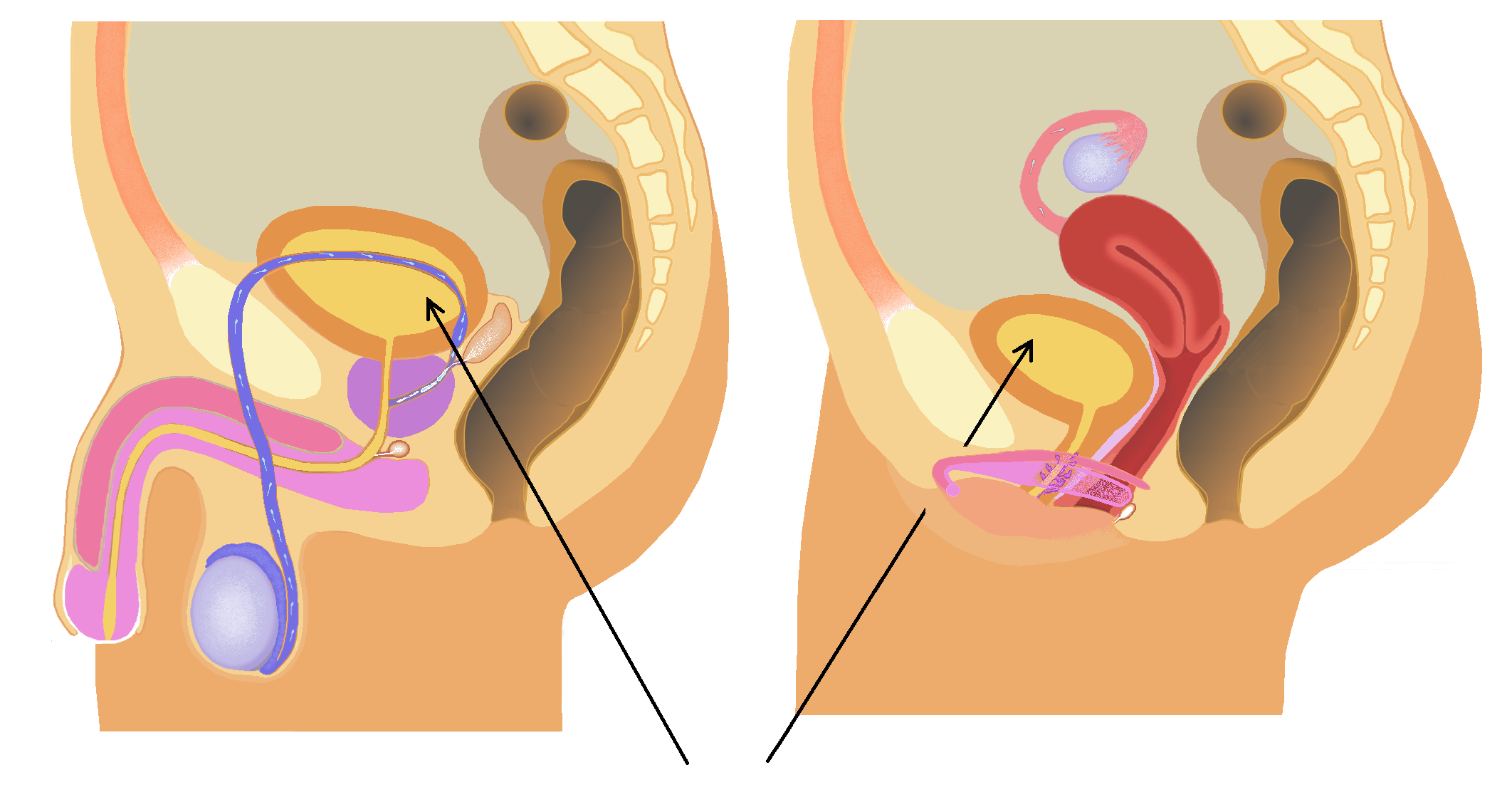|
Ectopic Ureter
Ectopic ureter (or ureteral ectopia) is a medical condition where the ureter, rather than terminating at the urinary bladder, terminates at a different site. In males this site is usually the urethra, in females this is usually the urethra or vagina. It can be associated with renal dysplasia, frequent urinary tract infections, and urinary incontinence (usually continuous drip incontinence). Ectopic ureters are found in 1 of every 2000–4000 patients, and can be difficult to diagnose, but are most often seen on CT scans. Ectopic ureter is commonly a result of a duplicated renal collecting system, a duplex kidney with 2 ureters. In this case, usually one ureter drains correctly to the bladder, with the duplicated ureter presenting as ectopic. The embryology that explains the pathology of an ectopic ureter is a cephalad origin of the ureteral bud on the mesonephric duct. With an abnormally long common excretory duct, the ureter never becomes incorporated into the bladder, and, th ... [...More Info...] [...Related Items...] OR: [Wikipedia] [Google] [Baidu] |
Ureteric Bud
The ureteric bud, also known as the metanephric diverticulum, is a protrusion from the mesonephric duct during the development of the urinary and reproductive organs. It later develops into a conduit for urine drainage from the kidneys, which, in contrast, originate from the metanephric blastema. References {{Authority control Embryology of urogenital system ... [...More Info...] [...Related Items...] OR: [Wikipedia] [Google] [Baidu] |
Rectum
The rectum (: rectums or recta) is the final straight portion of the large intestine in humans and some other mammals, and the gut in others. Before expulsion through the anus or cloaca, the rectum stores the feces temporarily. The adult human rectum is about long, and begins at the rectosigmoid junction (the end of the sigmoid colon) at the level of the third sacral vertebra or the sacral promontory depending upon what definition is used. Its diameter is similar to that of the sigmoid colon at its commencement, but it is dilated near its termination, forming the rectal ampulla. It terminates at the level of the anorectal ring (the level of the puborectalis sling) or the dentate line, again depending upon which definition is used. In humans, the rectum is followed by the anal canal, which is about long, before the gastrointestinal tract terminates at the anal verge. The word rectum comes from the Latin '' rēctum intestīnum'', meaning ''straight intestine''. Struc ... [...More Info...] [...Related Items...] OR: [Wikipedia] [Google] [Baidu] |
Duplex Kidney
Duplex (Latin, 'double') may refer to: Arts and entertainment * ''Duplex'' (film), or ''Our House'', a 2003 American black comedy film * Duplex (band), a Dutch electronic music duo * Duplex (Norwegian duo) * Duplex!, a Canadian children's music band * '' The Duplex'', an American comic strip by Glenn McCoy * ''The Duplex'' (film), a 2015 Nigerian film Places * Duplex, Tennessee, U.S. * Duplex, Texas, U.S. Science and technology * ''Duplex'' (moth), a genus of moths in the family Erebidae * Nucleic acid double helix, a double-stranded molecule of DNA or RNA * Duplex (telecommunications), communications in both directions simultaneously * Duplex (typography), a Linotype technique * Duplex ultrasonography, a medical imaging technique * Google Duplex, an extension of Google Assistant Transportation * Duplex (automobile), an early car built in Canada in 1923 * Duplex locomotive, a type of steam locomotive * TGV Duplex, a French high-speed train of the TGV family featuring bi- ... [...More Info...] [...Related Items...] OR: [Wikipedia] [Google] [Baidu] |
Duplicated Ureter
Duplicated ureter or duplex collecting system is a congenital condition in which the ureteric bud, the embryological origin of the ureter, splits (or arises twice), resulting in two ureters draining a single kidney. It is the most common renal abnormality, occurring in approximately 1% of the population.Siomou E. et alDuplex collecting system diagnosed during the first 6 years of life after a first urinary tract infection: a study of 63 children Journal of Urology, 2006; 175(2):678-81; discussion 681-2J. Gatti, J. Murphy, J. Williams, H. Koo, emedicine overviewUreteral Duplication, Ureteral Ectopia, and Ureterocele/ref> Pathophysiology Ureteral development begins in the human fetus around the 4th week of embryonic development. A ureteric bud, arising from the mesonephric (or Wolffian) duct, gives rise to the ureter, as well as other parts of the collective system. In the case of a duplicated ureter, the ureteric bud either splits or arises twice. In most cases, the kidney is divid ... [...More Info...] [...Related Items...] OR: [Wikipedia] [Google] [Baidu] |
CT Scans
A computed tomography scan (CT scan), formerly called computed axial tomography scan (CAT scan), is a medical imaging technique used to obtain detailed internal images of the body. The personnel that perform CT scans are called radiographers or radiology technologists. CT scanners use a rotating X-ray tube and a row of detectors placed in a gantry to measure X-ray attenuations by different tissues inside the body. The multiple X-ray measurements taken from different angles are then processed on a computer using tomographic reconstruction algorithms to produce tomographic (cross-sectional) images (virtual "slices") of a body. CT scans can be used in patients with metallic implants or pacemakers, for whom magnetic resonance imaging (MRI) is contraindicated. Since its development in the 1970s, CT scanning has proven to be a versatile imaging technique. While CT is most prominently used in medical diagnosis, it can also be used to form images of non-living objects. The 1979 Nobe ... [...More Info...] [...Related Items...] OR: [Wikipedia] [Google] [Baidu] |
Urinary Incontinence
Urinary incontinence (UI), also known as involuntary urination, is any uncontrolled leakage of urine. It is a common and distressing problem, which may have a significant effect on quality of life. Urinary incontinence is common in older women and has been identified as an important issue in geriatric health care. The term enuresis is often used to refer to urinary incontinence primarily in children, such as nocturnal enuresis (bed wetting). UI is an example of a stigmatized medical condition, which creates barriers to successful management and makes the problem worse. People may be too embarrassed to seek medical help, and attempt to self-manage the symptom in secrecy from others. Pelvic surgery, pregnancy, childbirth, attention deficit disorder (ADHD), and menopause are major risk factors. Urinary incontinence is often a result of an underlying medical condition but is under-reported to medical practitioners. There are four main types of incontinence: * Urge incontinence ... [...More Info...] [...Related Items...] OR: [Wikipedia] [Google] [Baidu] |
Urinary Tract Infections
A urinary tract infection (UTI) is an infection that affects a part of the urinary tract. Lower urinary tract infections may involve the bladder (cystitis) or urethra ( urethritis) while upper urinary tract infections affect the kidney (pyelonephritis). Symptoms from a lower urinary tract infection include suprapubic pain, painful urination (dysuria), frequency and urgency of urination despite having an empty bladder. Symptoms of a kidney infection, on the other hand, are more systemic and include fever or flank pain usually in addition to the symptoms of a lower UTI. Rarely, the urine may appear bloody. Symptoms may be vague or non-specific at the extremities of age (i.e. in patients who are very young or old). The most common cause of infection is ''Escherichia coli'', though other bacteria or fungi may sometimes be the cause. Risk factors include female anatomy, sexual intercourse, diabetes, obesity, catheterisation, and family history. Although sexual intercourse is a ... [...More Info...] [...Related Items...] OR: [Wikipedia] [Google] [Baidu] |
Renal Dysplasia
Multicystic dysplastic kidney (MCDK) is a condition that results from the malformation of the kidney during fetal development. The kidney consists of irregular cysts of varying sizes. Multicystic dysplastic kidney is a common type of renal cystic disease, and it is a cause of an abdominal mass in infants. Signs and symptoms When a diagnosis of multicystic kidney is made in utero by ultrasound, the disease is found to be bilateral in many cases. Those with bilateral disease often have other severe deformities or polysystemic malformation syndromes. In bilateral cases, the newborn has the classic characteristic of Potter's syndrome. The bilateral condition is incompatible with survival, as the contralateral system frequently is abnormal as well. Contralateral ureteropelvic junction obstruction is found in 3% to 12% of infants with multicystic kidney and contralateral vesicoureteral reflux is seen even more often, in 18% to 43% of infants. Because the high incidence of reflux, ... [...More Info...] [...Related Items...] OR: [Wikipedia] [Google] [Baidu] |
Vagina
In mammals and other animals, the vagina (: vaginas or vaginae) is the elastic, muscular sex organ, reproductive organ of the female genital tract. In humans, it extends from the vulval vestibule to the cervix (neck of the uterus). The #Vaginal opening and hymen, vaginal introitus is normally partly covered by a thin layer of mucous membrane, mucosal tissue called the hymen. The vagina allows for Copulation (zoology), copulation and birth. It also channels Menstruation (mammal), menstrual flow, which occurs in humans and closely related primates as part of the menstrual cycle. To accommodate smoother penetration of the vagina during sexual intercourse or other sexual activity, vaginal moisture increases during sexual arousal in human females and other female mammals. This increase in moisture provides vaginal lubrication, which reduces friction. The texture of the vaginal walls creates friction for the penis during sexual intercourse and stimulates it toward ejaculation, en ... [...More Info...] [...Related Items...] OR: [Wikipedia] [Google] [Baidu] |
Urinary Bladder
The bladder () is a hollow organ in humans and other vertebrates that stores urine from the Kidney (vertebrates), kidneys. In placental mammals, urine enters the bladder via the ureters and exits via the urethra during urination. In humans, the bladder is a distensible organ that sits on the pelvic floor. The typical adult human bladder will hold between 300 and (10 and ) before the urge to empty occurs, but can hold considerably more. The Latin phrase for "urinary bladder" is ''vesica urinaria'', and the term ''vesical'' or prefix ''vesico-'' appear in connection with associated structures such as vesical veins. The modern Latin word for "bladder" – ''cystis'' – appears in associated terms such as cystitis (inflammation of the bladder). Structure In humans, the bladder is a hollow muscular organ situated at the base of the pelvis. In gross anatomy, the bladder can be divided into a broad (base), a body, an apex, and a neck. The apex (also called the vertex) is directed ... [...More Info...] [...Related Items...] OR: [Wikipedia] [Google] [Baidu] |
Hindgut
The hindgut (or epigaster) is the posterior ( caudal) part of the alimentary canal. In mammals, it includes the distal one third of the transverse colon and the splenic flexure, the descending colon, sigmoid colon and up to the ano-rectal junction. In zoology, the term ''hindgut'' refers also to the cecum and ascending colon. Structure Blood supply Arterial supply is by the inferior mesenteric artery, and venous drainage is to the portal venous system. Lymphatic drainage is to the chyle cistern. Nerve supply The hindgut is innervated via the inferior mesenteric plexus. Sympathetic innervation is from the lumbar splanchnic nerves (L1-L2), parasympathetic innervation is from S2-S4. Development Additional images File:Gray985.png, Abdominal part of digestive tube and its attachment to the primitive or common mesentery. Human embryo of six weeks. File:Gray1115.png, Tail end of human embryo twenty-five to twenty-nine days old. File:Illacme plenipes female with 170 segments a ... [...More Info...] [...Related Items...] OR: [Wikipedia] [Google] [Baidu] |
Ureter
The ureters are tubes composed of smooth muscle that transport urine from the kidneys to the urinary bladder. In an adult human, the ureters typically measure 20 to 30 centimeters in length and about 3 to 4 millimeters in diameter. They are lined with urothelial cells, a form of transitional epithelium, and feature an extra layer of smooth muscle in the lower third to aid in peristalsis. The ureters can be affected by a number of diseases, including urinary tract infections and kidney stone. is when a ureter is narrowed, due to for example chronic inflammation. Congenital abnormalities that affect the ureters can include the development of two ureters on the same side or abnormally placed ureters. Additionally, reflux of urine from the bladder back up the ureters is a condition commonly seen in children. The ureters have been identified for at least two thousand years, with the word "ureter" stemming from the stem relating to urinating and seen in written records since at ... [...More Info...] [...Related Items...] OR: [Wikipedia] [Google] [Baidu] |







